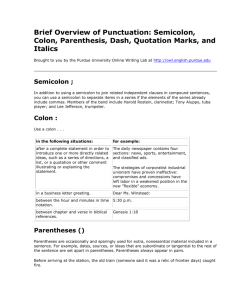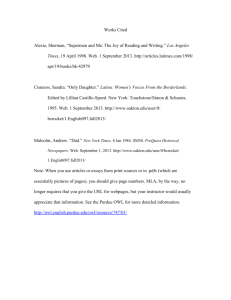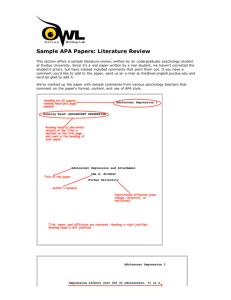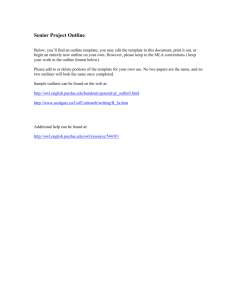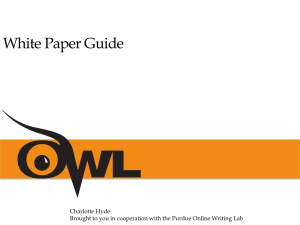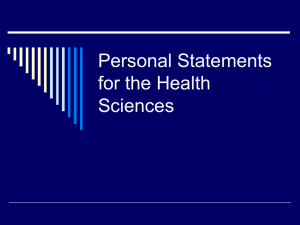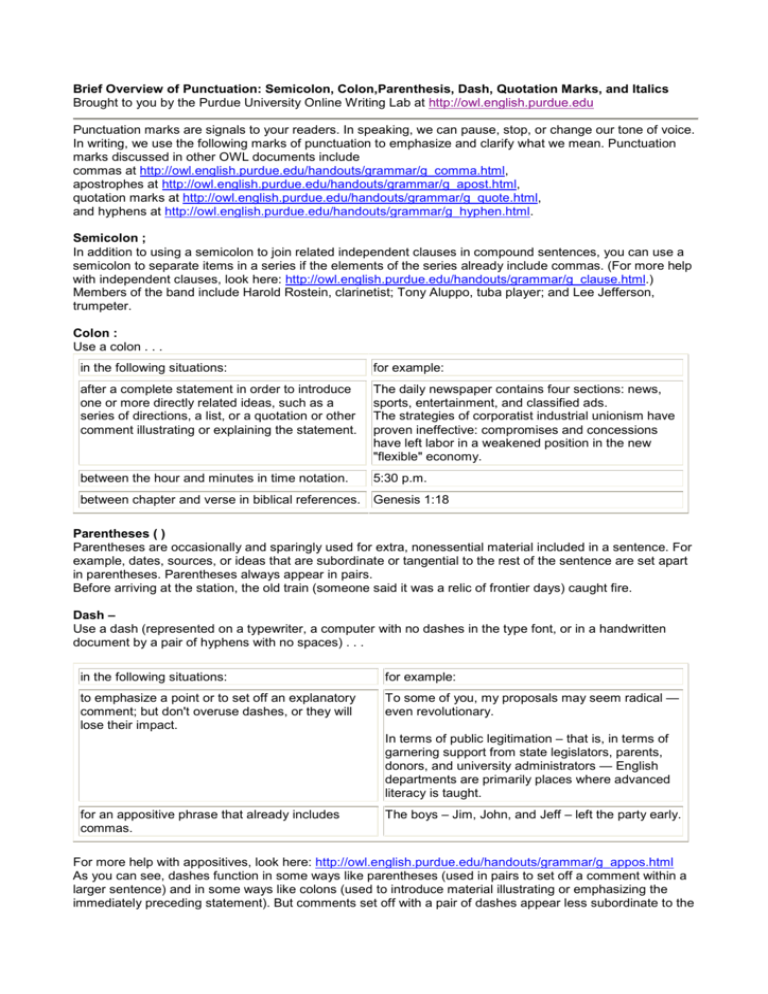
Brief Overview of Punctuation: Semicolon, Colon,Parenthesis, Dash, Quotation Marks, and Italics
Brought to you by the Purdue University Online Writing Lab at http://owl.english.purdue.edu
Punctuation marks are signals to your readers. In speaking, we can pause, stop, or change our tone of voice.
In writing, we use the following marks of punctuation to emphasize and clarify what we mean. Punctuation
marks discussed in other OWL documents include
commas at http://owl.english.purdue.edu/handouts/grammar/g_comma.html,
apostrophes at http://owl.english.purdue.edu/handouts/grammar/g_apost.html,
quotation marks at http://owl.english.purdue.edu/handouts/grammar/g_quote.html,
and hyphens at http://owl.english.purdue.edu/handouts/grammar/g_hyphen.html.
Semicolon ;
In addition to using a semicolon to join related independent clauses in compound sentences, you can use a
semicolon to separate items in a series if the elements of the series already include commas. (For more help
with independent clauses, look here: http://owl.english.purdue.edu/handouts/grammar/g_clause.html.)
Members of the band include Harold Rostein, clarinetist; Tony Aluppo, tuba player; and Lee Jefferson,
trumpeter.
Colon :
Use a colon . . .
in the following situations:
for example:
after a complete statement in order to introduce
one or more directly related ideas, such as a
series of directions, a list, or a quotation or other
comment illustrating or explaining the statement.
The daily newspaper contains four sections: news,
sports, entertainment, and classified ads.
The strategies of corporatist industrial unionism have
proven ineffective: compromises and concessions
have left labor in a weakened position in the new
"flexible" economy.
between the hour and minutes in time notation.
5:30 p.m.
between chapter and verse in biblical references. Genesis 1:18
Parentheses ( )
Parentheses are occasionally and sparingly used for extra, nonessential material included in a sentence. For
example, dates, sources, or ideas that are subordinate or tangential to the rest of the sentence are set apart
in parentheses. Parentheses always appear in pairs.
Before arriving at the station, the old train (someone said it was a relic of frontier days) caught fire.
Dash –
Use a dash (represented on a typewriter, a computer with no dashes in the type font, or in a handwritten
document by a pair of hyphens with no spaces) . . .
in the following situations:
for example:
to emphasize a point or to set off an explanatory
comment; but don't overuse dashes, or they will
lose their impact.
To some of you, my proposals may seem radical —
even revolutionary.
In terms of public legitimation – that is, in terms of
garnering support from state legislators, parents,
donors, and university administrators — English
departments are primarily places where advanced
literacy is taught.
for an appositive phrase that already includes
commas.
The boys – Jim, John, and Jeff – left the party early.
For more help with appositives, look here: http://owl.english.purdue.edu/handouts/grammar/g_appos.html
As you can see, dashes function in some ways like parentheses (used in pairs to set off a comment within a
larger sentence) and in some ways like colons (used to introduce material illustrating or emphasizing the
immediately preceding statement). But comments set off with a pair of dashes appear less subordinate to the
main sentence than do comments in parentheses. And material introduced after a single dash may be more
emphatic and may serve a greater variety of rhetorical purposes than material introduced with a colon.
Quotation Marks " "
Use quotation marks . . .
in the following situations:
for example:
to enclose direct quotations. Note that commas and He asked, "Will you be there?" "Yes," I answered,
periods go inside the closing quotation mark in
"I'll look for you in the foyer."
conventional American usage; colons and
semicolons go outside; and placement of question
and exclamation marks depends on the situation
(see our quotation marks document).
to indicate words used ironically, with reservations,
or in some unusual way; but don't overuse
quotation marks in this sense, or they will lose their
impact.
History is stained with blood spilled in the name of
"civilization."
For more information on writing research papers and using quotations, see our workshop on writing research
papers here http://owl.english.purdue.edu/workshops/hypertext/ResearchW/index.html.
Underlining and Italics
Underlining and italics are not really punctuation, but they are significant textual effects used conventionally in
a variety of situations. Before computerized word-processing was widely available, writers would underline
certain terms in handwritten or manually typed pages, and the underlining would be replaced by italics in the
published version. Since word processing today allows many options for font faces and textual effects, it is
generally recommended that you choose either underlining or italics and use it consistently throughout a
given document as needed. Because academic papers are manuscripts and not final publications and
because italics are not always easily recognized with some fonts, many instructors prefer underlining over
italics for course papers. Whichever you choose, italics or underlining should be used . . .
in the following situations:
for example:
to indicate titles of complete or major works such as Faulkner's last novel was The Reivers.
magazines, books, newspapers, academic journals, The Simpsons offers hilarious parodies of American
films, television programs, long poems, plays of
culture and family life.
three or more acts
foreign words that are not commonly used in
English
Wearing blue jeans is de rigueur for most college
students.
words used as words themselves
The English word nuance comes from a Middle
French word meaning "shades of color."
words or phrases that you wish to emphasize
The very founding principles of our nation are at
stake!
After reviewing this handout, you can try the Purdue OWL exercise on semicolons, parentheses, dashes,
quotation marks and italics (and then check your answers). You can find it here:
http://owl.english.purdue.edu/handouts/grammar/g_overvwEX1.html
This page is located at http://owl.english.purdue.edu/handouts/print/grammar/g_overvw.html
Copyright ©1995-2004 by OWL at Purdue University and Purdue University. All rights reserved.
Using Colons and Semi-Colons
Introduction
The most common punctuation marks in English are probably the period and the comma. However, good
writing in English will usually make use of the colon and the semi-colon. Although these look similar and
have similar names, their functions are completely different. This page will explain the functions of the colon
and the semi-colon.
The colon
A colon consists of two dots, one above the other: :
The colon is often used to introduce a list of items. For example:
You will need to bring three things to the party: some food, something to drink, and a small gift for the
hostess.
This sentence contains a list of three items. The first part of the sentence tells you that there will be three
things; then the colon tells you "here are the three things".
You can also use a colon to introduce an explanation or a definition of something. For instance:
I'll tell you what I'm going to do: I'm going to quit!
"Elephant (noun): a large grey mammal found in Africa and India."
The semi-colon
A semi-colon consists of a comma with a dot above it: ;
The semi-colon is often used to join together two independent clauses -- in other words, it joins two clauses
that could be sentences. For example:
Mary drives a Mercedes; Joanne drives a Chevrolet.
These two clauses could be separate sentences: "Mary drives a Mercedes. Joanne drives a Chevrolet."
However, when we use a semi-colon, we are usually suggesting that there is a relationship between the
sentences, but we are not making that relationship clear. Usually, you can tell from the context what the
relationship is. In the example above, the relationship is probably CONTRAST; we could also use "but" to
make this clear: "Mary drives a Mercedes, but Joanne drives a Chevrolet." When we use a semi-colon, it is
often because we want to make the reader think about the relationship for herself. This is useful in many
situations, such as when writing cautiously, ironically, or humorously.
One more very common use of the semi-colon is to join two clauses using a transition such as however,
therefore, on the other hand, etc. Here are some examples:
Transition
Example
in
addition
She works all day in a store; in addition, she takes classes in the evenings.
however
John is Canadian; however, he lives in the United States.
otherwise
You should get your brakes fixed; otherwise, you might have an accident.
therefore
Hundreds of people cross the border from the US to Canada every day; therefore, it
is not possible to search all of them carefully.
http://web2.uvcs.uvic.ca/elc/studyzone/410/grammar/colons.htm
Semicolon
1. Separates the clauses of a compound sentence having no coordinating conjunction: Do not let us
speak of darker days; let us rather speak of sterner days.—Winston Churchill
2. Separates the clauses of a compound sentence in which the clauses contain internal punctuation,
even when the clauses are joined by conjunctions: Skis in hand, we trudged to the lodge, stowed our
lunches, and donned our boots; and the rest of our party waited for us at the lifts.
3. Separates elements of a series in which items already contain commas: Among those at the
diplomatic reception were the Secretary of State; the daughter of the Ambassador to the Court of St.
James's, formerly of London; and two United Nations delegates.
4. Separates clauses of a compound sentence joined by a conjunctive adverb, such as however,
nonetheless, or hence: We insisted upon a hearing; however, the Grievance Committee refused.
5. May be used instead of a comma to signal longer pauses for dramatic effect: But I want you to know
that when I cross the river my last conscious thought will be of the Corps; and the Corps; and the
Corps.—General Douglas MacArthur
http://www.factmonster.com/ipka/A0771370.html

